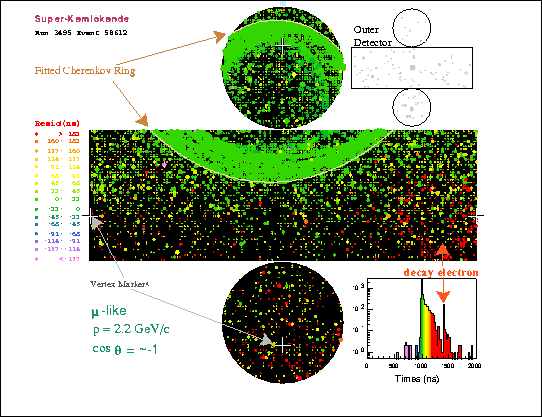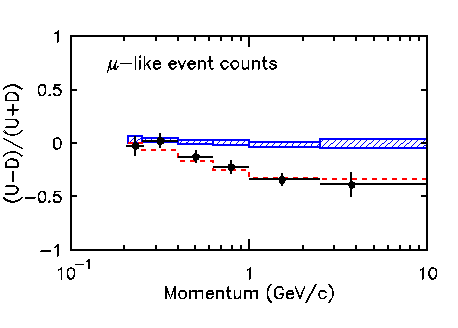
Postscript Version
Atmospheric neutrinos are produced as the decay products from particles produced in collisions of cosmic rays with air in the upper atmosphere. The neutrinos travel to the detector, where they interact with neucli in the water to produce charged particles. These charges particles (electrons, and muons) produce Cherenkov light from which we can ascertain information about the neutrino that produced it. The following diagrams shows this process.

Evidence for neutrino mass comes from the fact that we don't see enough of these kinds of interactions:
 Postscript Version
Postscript Version
In this view, the can-shaped detector has been unrolled. To put it back together you would wrap the left side if the rectangular region over to the right side and fold the top and bottom circles towards you off the page. This interaction was produced by a muon neutrino traveling almost vertically upward through the detector. The light from the muon lights up the top of the detector making its direction clear. The muon stopped in the tank and then later decayed to an electron which also produced Cherenkov light (see the red hits in the timing diagram). The neutrinos that produce interactions like this one must travel the full diameter of the Earth before they get to the detector and are therefore far more likely to oscillate to other flavors such as tau or perhaps even a "sterile" (one that does not interact at all) neutrino type.
The top right hand side of the picture shows the outer detector. This detector completely surrounds the inner detector and is used to identify particles that enter or exit the inner detector. Because there is no cluster of light in the outer detector for this event we know that only the stealthy neutrino entered the detector and no particles exited.
The deficit of these muon-like events from below varies with muon momentum in just the way we would expect if the muon neutrinos were oscillating on their way to the detector. In the figure below the deficit of upward-going muon-events is measured by the up-down asymmetry : A = (U-D)/(U+D) where U is the number of upward-going events and D is the number of downward going events. A=1 means that all the events are up-going and A=-1 means that all the events are down-going. The expectation for no neutrino oscillations is shown in blue and the expectation for neutrino oscillations is shown in red. Data from Super-Kamiokande is shown by the black dots with crosses.

Atmospheric neutrinos also interact in the rock beneath the
detector producing muons which travel through our detector. These "upward-going muons" provide us with another tool
to study atmospheric neutinos and neutrino oscillations.
Comments to messier@budoe.bu.edu .